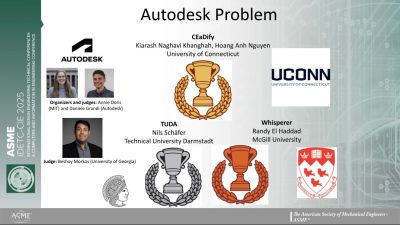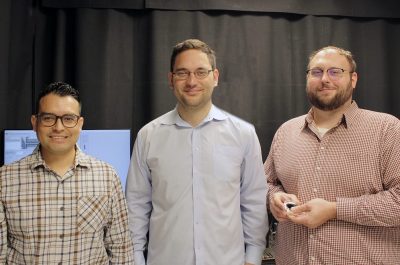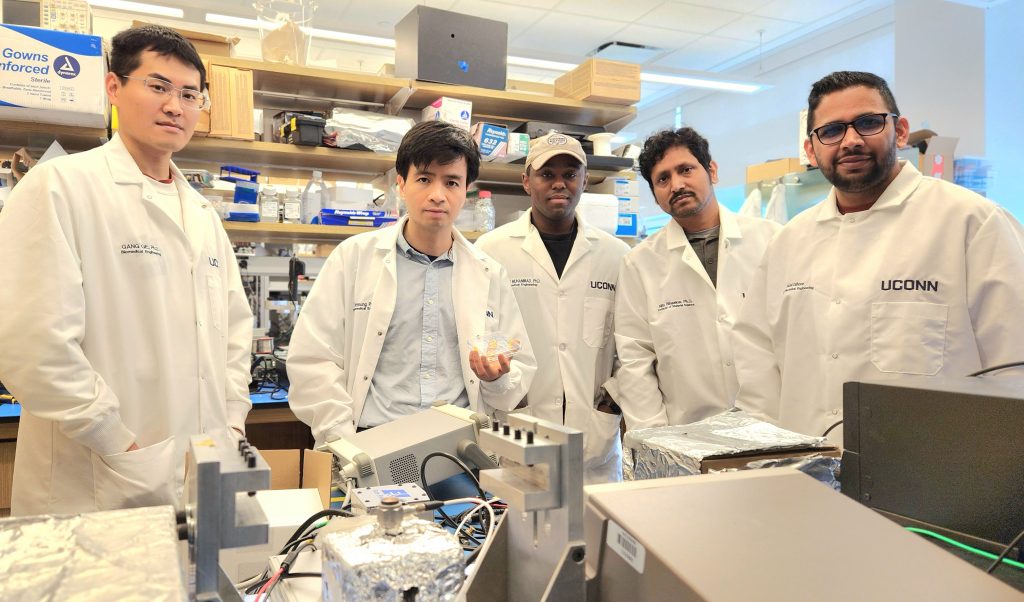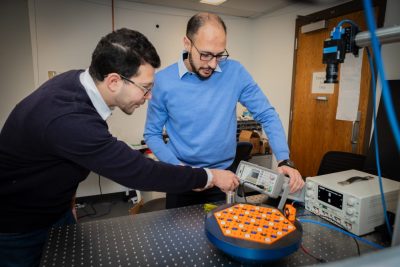🎉 Welcome Dr. Daniele Vivona! 🎉
We are excited to welcome Dr. Daniele Vivona as an Assistant Professor in the School of Mechanical, Aerospace, and Manufacturing Engineering and the UConn Center for Clean Energy Engineering at the University of Connecticut!
Dr. Vivona’s research explores atom-level energy conversion processes to develop innovative design solutions for ion transport and interfacial phenomena in advanced energy materials. His work aims to drive forward next-generation electrochemical energy conversion devices, combining physics-based modeling, atomistic simulations, and data-driven approaches to bridge multiple time and length scales.
Dr. Vivona earned his Ph.D. in Mechanical Engineering from MIT, where he was a MathWorks Mechanical Engineering Fellow, a Rohsenow Graduate Fellow, and a member of the MIT Society of Energy Fellows. He also holds B.Sc. and M.S. degrees in Energy Engineering from the Polytechnic Institute of Milan, and an M.S. in Mechanical Engineering from UConn.
Author: Ilies, Horea
MAM Graduate Students Take Top Spot at International ASME Student Hackathon

A team of graduate students from our School of MAM’s Computational Engineering and Design (CEaD) Lab won first place in the Autodesk challenge at the ASME IDETC/CIE 2025 Student Hackathon, held August 10–17 in Anaheim, California.
Ph.D. students Kiarash Naghavi Khanghah and Hoang Anh Nguyen, advised by Dr. Hongyi Xu, earned the top spot and a $1,400 prize for their innovative solution.
This year’s hackathon drew more than 55 participants from 33 universities across six countries, challenging students to solve real-world problems in design, manufacturing, and simulation.
The UConn team tackled Autodesk’s DesignQA challenge, which tested how well AI systems could read and reason over complex engineering documents. They built a large language model–based framework that improved rule extraction, reduced model hallucinations, and achieved one of the highest scores on the benchmark, securing their first-place win.
UConn Alum Wins ASME Best Dissertation Award
 UConn graduate Zihan Wang (’24 PhD) has been honored with the ASME Design Automation Best Dissertation Award for her groundbreaking research in metamaterials. Her dissertation, “Design, Performance Evaluation and Uncertainty Analysis of Metamaterials,” was completed under the guidance of Dr. Hongyi Xu, Associate Professor in the School of Mechanical, Aerospace, and Manufacturing Engineering.
UConn graduate Zihan Wang (’24 PhD) has been honored with the ASME Design Automation Best Dissertation Award for her groundbreaking research in metamaterials. Her dissertation, “Design, Performance Evaluation and Uncertainty Analysis of Metamaterials,” was completed under the guidance of Dr. Hongyi Xu, Associate Professor in the School of Mechanical, Aerospace, and Manufacturing Engineering.
Dr. Wang’s work introduced new methods to design advanced materials using generative AI, predict their properties with deep learning, and better understand the uncertainties involved in their performance.
The ASME Design Automation Dissertation Award is given to recognize one exceptional Ph.D. dissertation in the field each year—or less often—making it a highly selective honor. Dr. Wang received the award at the ASME 2025 IDETC/CIE Conference, highlighting UConn’s leadership in training researchers to take on today’s most complex engineering challenges.
UConn Researchers Win Distinguished ASME Best Paper Award
 |
 |
Prof. Hongyi Xu and Prof. Farhad Imani |
|
A team of researchers from UConn has received the 2025 ASME Design for Manufacturing and the Life Cycle (DFMLC) Best Paper Award, a national honor given to only one paper each year. The award was presented at the ASME 2025 International Design Engineering Technical Conferences & Computers and Information in Engineering Conference (IDETC/CIE), held August 10–17 in Anaheim, California.
The winning paper introduces a new artificial intelligence framework that helps detect problems in advanced 3D printing processes, also known as additive manufacturing. By combining powerful language models with scientific data, such as images and text from research articles, the system can automatically spot and explain manufacturing defects without needing prior training on each specific case. The team successfully tested this method on several datasets from Oak Ridge National Laboratory, covering different machines, materials, and conditions.
The research was carried out by Kiarash Naghavi Khanghah, Zhiling Chen, Lela Romeo, Dr. Qian Yang, Dr. Rajiv Malhotra, Dr. Farhad Imani, and Dr. Hongyi Xu, in collaboration across the UConn School of Mechanical, Aerospace, and Manufacturing Engineering, the UConn School of Computing, and the Rutgers Department of Mechanical and Aerospace Engineering.
A preprint of the paper is available through this link https://arxiv.org/abs/2505.13828
MAM Student Pursues In-Depth Research Project as University Scholar

Zhengyang Wei ’26, a mechanical engineering major and University Scholar, is conducting advanced research to improve the stability and efficiency of aerodynamic systems. His project focuses on analyzing shear flows, where fluid layers move at different speeds, to understand and prevent turbulence, a key challenge in fluid dynamics. Using mathematical models and stability theorems, Wei’s work aims to enhance the performance of systems like aircraft by reducing turbulent transitions.
Working under the guidance of faculty members Chang Liu, Reza Sheikhi, and Jason Lee in the School of Mechanical, Aerospace, and Manufacturing Engineering, Wei has already co-published a research paper and received a 2025 Summer Undergraduate Research Fund (SURF) award. As a member of the FLUENT Lab and a math minor, he plans to pursue a Ph.D. in fluid stability or optimization.
Making Electronic Devices Faster, More Powerful, and Better at Staying Cool
by Olivia Drake
In a paper published as an Editor’s Pick in Applied Physics Letters, College of Engineering’s Georges Pavlidis outlines ways to manage heat in high-speed electronic.
When electronic devices overheat, they can slow down, malfunction, or stop working altogether. This heat is mainly caused by energy lost as electrons move through a material—similar to friction in a moving machine.
Most devices today use silicon (Si) as their semiconductor material. However, engineers are increasingly turning to alternatives like gallium nitride (GaN) for longer lifetime use and higher performance. This includes products such as LEDs, compact laptop chargers, and 5G phone networks. For even more extreme applications—such as high-voltage systems or harsh environments—researchers are exploring ultrawide bandgap (UWBG) materials like gallium oxide (Ga2O3), aluminum gallium nitride (AlGaN), and even diamond.

The key difference between these materials lies in their electronic bandgap—the energy needed to get electrons to flow through the material. Wider bandgaps allow companies to reduce the size of their electronics and make them more electrically efficient.
“UWBG materials can resist up to 8,000 volts and can operate at temperatures over 200 °C (392°F), making them promising for the next generation of electronics in the energy, health, and communication sectors,” explains Georges Pavlidis, assistant professor of mechanical engineering.
While these materials offer promising advantages, they also come with challenges. They’re currently expensive, difficult to manufacture, and their thermal behavior is hard to measure precisely. As electronics become more powerful and in smaller dimensions, the heating in the device becomes more localized and can generate a heat flux greater than the sun, Pavlidis explains.
“Chip manufacturers need new methods to measure temperature in smaller dimensions,” he says.
Pavlidis, along with UConn’s School of Mechanical, Aerospace, and Manufacturing Engineering Ph.D. candidates Dominic Myren and Francis Vásquez, collaborated with colleagues from the U.S. Naval Research Laboratory over the past year to tackle the challenge of measuring the heat output. Their work resulted in a “Perspectives” paper published in Applied Physics Letters.
Nguyen’s Injectable Piezoelectric Gel Could Treat Osteoarthritis without Surgery
Backed by a $2.3M grant from the NIH and NIH/NIBIB, Thanh Nguyen will stimulate cartilage regeneration in large animal model.

Millions of Americans suffer from osteoarthritis, a painful joint disease that wears down cartilage and can severely impact mobility. Pain medications only mask symptoms, and surgical option carry risks of infection and immune rejection.
At the University of Connecticut, a research team led by Thanh Nguyen, associate professor of mechanical engineering and biomedical engineering, believes the future of joint repair might lie in a tiny electrical spark—and a simple injection.
Backed by a $2.3M grant from the National Institutes of Health (NIH) and National Institute of Biomedical Imaging and Bioengineering (NIBIB), Nguyen and his team are developing an injectable hydrogel designed to stimulate cartilage regeneration in large animal models.
“With current treatments, we’re managing the pain, not healing the tissue,” says Nguyen. “We’re hoping that the body’s own mechanical movements—like walking—can generate tiny electrical signals that encourage cartilage to grow back.”
The innovation harnesses the body’s natural bioelectric signals to promote healing. The injectable gel contains a piezoelectric scaffold—a composite made from biodegradable poly-L-lactic acid (PLLA) nanofibers and magnesium oxide nanoparticles. When subjected to mechanical stress—such as joint movement or ultrasound—this scaffold generates small electrical charges.
Tarakanova Honored with Eshelby Mechanics Award for Young Faculty
As the body ages, a network of proteins and other molecules may structurally change, leading to a loss of elasticity and tissue strength in skin, joints, and arteries. This can lead to reduced muscle mass, stiffness, and increased susceptibility to chronic diseases like osteoarthritis.
 Anna Tarakanova, assistant professor of mechanical engineering and biomedical engineering, leads a research group in UConn’s College of Engineering (CoE) that uses advanced computer models to study the mechanical properties of proteins.
Anna Tarakanova, assistant professor of mechanical engineering and biomedical engineering, leads a research group in UConn’s College of Engineering (CoE) that uses advanced computer models to study the mechanical properties of proteins.
In doing so, she’s developing nature-inspired materials that can mimic the flexibility of elastin or the durability of collagen. These designs could lead to innovations in medical devices, prosthetics, or even “repurpose” molecules for resilience in aging.
“Ultimately, our goal is to understand aging and disease at a basic, molecular level and how that fits into the bigger picture of how complex biological systems function,” Tarakanova explains.
Sound Waves Go Flat
by

A team of UConn College of Engineering (CoE) researchers have achieved a major milestone in the field of Phononics with the first experimental demonstration of an all-flat phononic band structure (AFB). Phononics concerns the study of sound and heat control. A breakthrough, detailed in an article just published in Physical Review Letters, introduces a new class of materials capable of uniquely controlling sound and vibrations by trapping energy with unprecedented intensity, offering exciting possibilities for potential applications in acoustics, vibration insulation, energy harvesting, and beyond.
The work, led by Professor Osama Bilal, director of the Wave Engineering Laboratory for Extreme and Intelligent Matter (We-Xite), unlocks a new recipe for engineering materials with exotic behavior. In the experiments, the material serves a double function, Bilal explains, by being a perfect sound vacuum and wave amplifier at the same time.